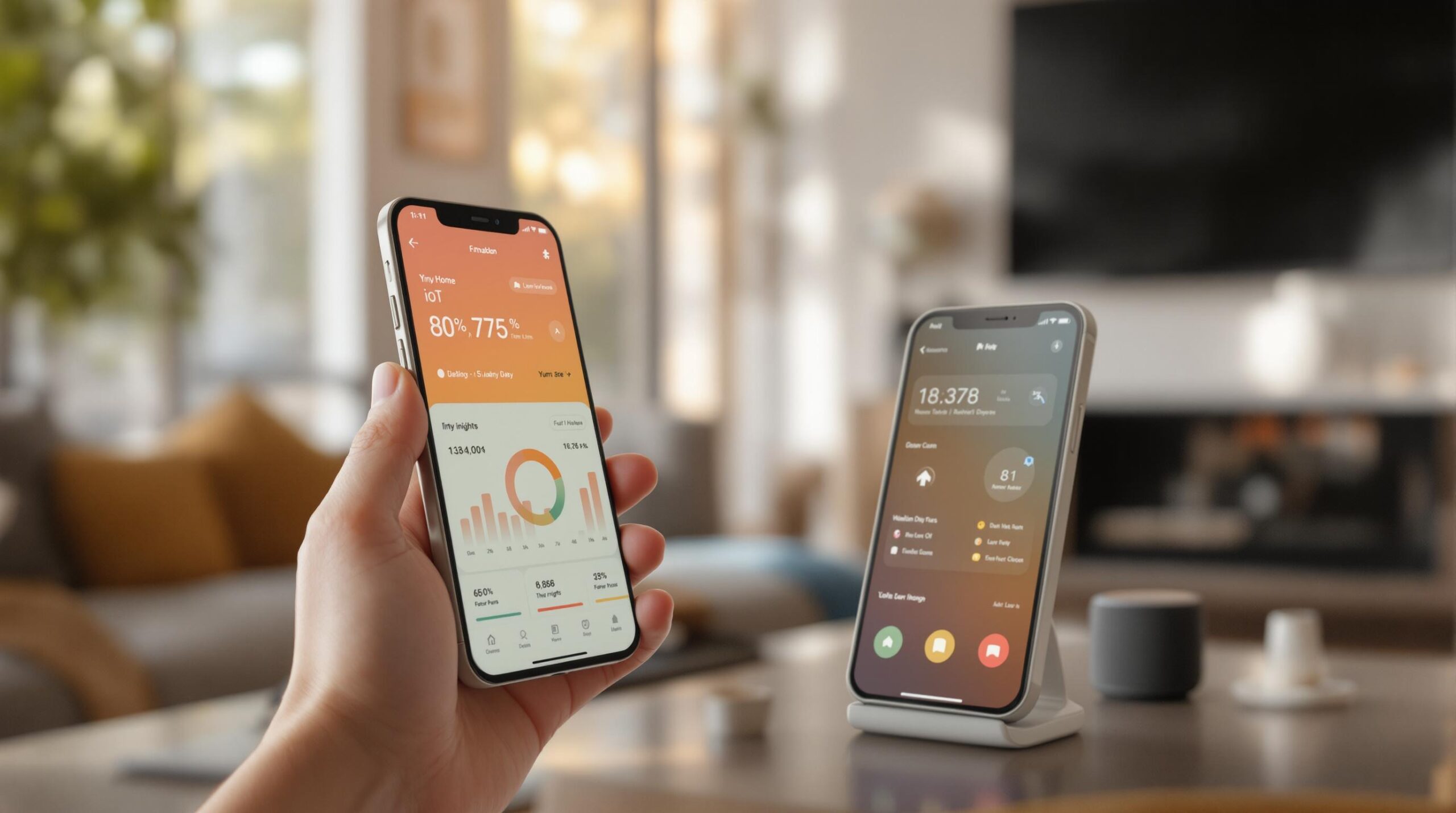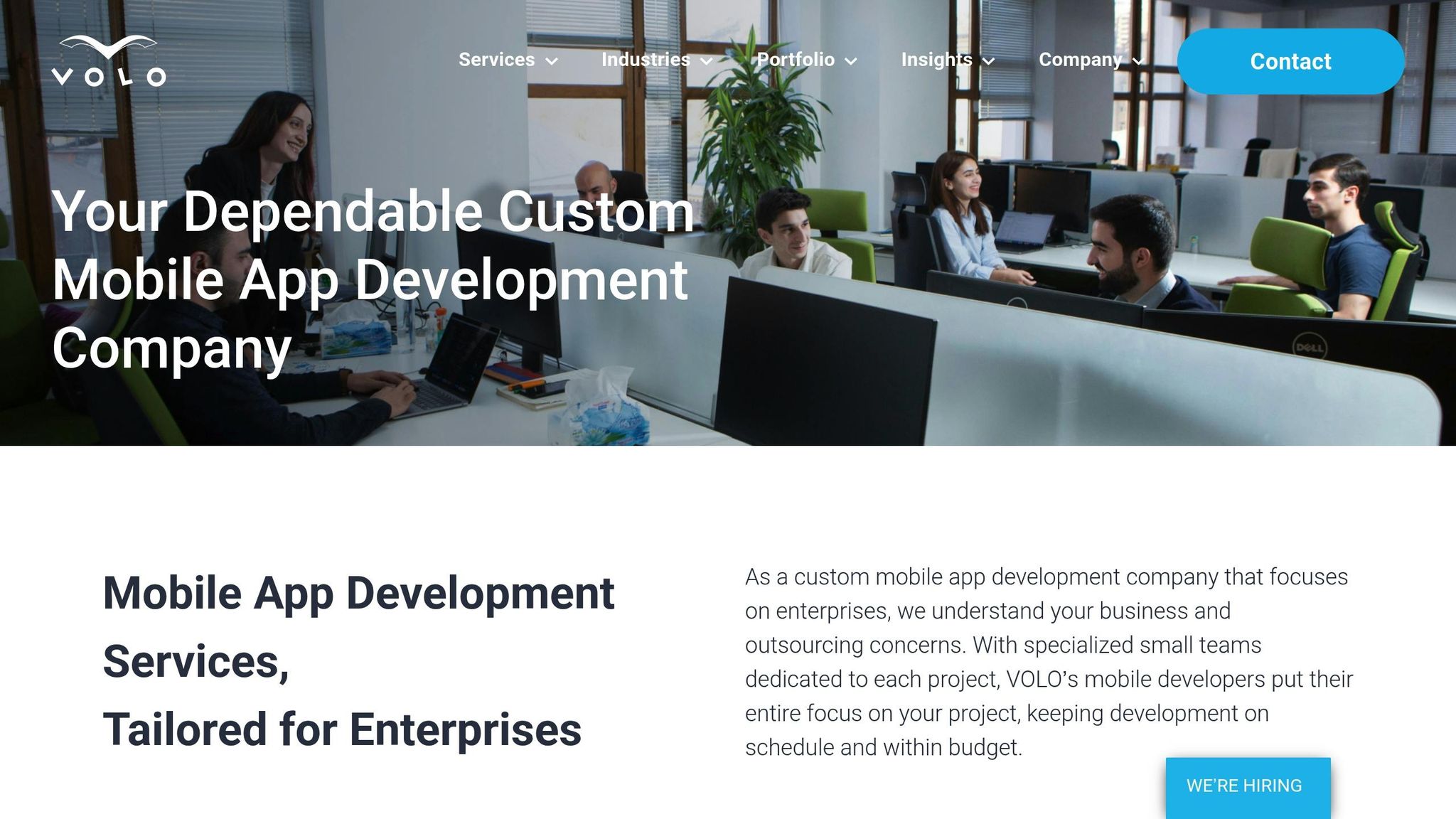
A custom mobile app can make your IoT product more competitive by improving user experience, device control, and data insights. Here’s how:
- Simplifies Setup: Features like step-by-step guides and automatic device detection make onboarding easy.
- Enhances Control: Apps act as hubs for managing devices, offering real-time updates and remote access.
- Provides Data Insights: Visualize and analyze data to help users make smarter decisions.
- Boosts Security: Adds encryption and multi-factor authentication to protect user data.
- Scales with Growth: Supports future technologies like AI, edge computing, and real-time analytics.
With 52% of people accessing the internet via mobile devices and the IoT market projected to exceed $1.1 trillion by 2026, investing in a custom mobile app can help your product meet rising expectations and stand out in a crowded space.
Current IoT Market Challenges
IoT Market Growth and Competition
The IoT industry is expanding quickly, but the competition is becoming tougher, especially as product development cycles take longer. Since 2020, the time-to-market for connected products has jumped by 80%, now averaging 41 months. This delay is largely due to more complex product designs and stricter regulatory standards. In the European Union, 71% of Original Equipment Manufacturers (OEMs) say they feel limited by new privacy and security regulations.
Common IoT Product Limitations
IoT products often face challenges that can impact their success in the market:
- Security Weaknesses: Many IoT devices lack strong protection, making them easy targets for cyberattacks.
- Complicated Device Management: As IoT networks grow, maintaining performance while handling updates and maintenance becomes harder.
- Compatibility Problems: Many devices struggle to work smoothly with other platforms or products, reducing their overall appeal and usability.
These challenges highlight the need for solutions that address these issues effectively.
Mobile Apps as IoT Solutions
Mobile apps have become a powerful way to tackle these IoT challenges. With 52% of the global population using mobile devices to access the internet, apps are a practical tool for enhancing IoT functionality.
- Better Control and Monitoring: Mobile apps let users manage IoT devices remotely, providing real-time updates and controls. This is especially useful for smart homes and industrial setups where quick responses are crucial.
- Data Insights and Decision-Making: IoT-enabled apps can analyze and display device data in easy-to-understand formats, helping users make smarter choices. In fact, McKinsey estimates IoT could add $3.9 to $11.1 trillion to the global economy by 2025, largely thanks to data-driven insights.
- Stronger Security Features: Mobile apps serve as secure gateways for IoT devices, integrating encryption and authentication to protect user data. This is increasingly important as privacy and security become top priorities.
Benefits of Custom IoT Mobile Apps
Improved User Experience
Custom IoT mobile apps make life easier by automating repetitive tasks and providing intuitive controls. These apps adapt to user habits, adjusting settings to fit daily routines. For instance, smart home systems can analyze your preferences for temperature, lighting, and security, then create automated schedules – no manual adjustments needed. On top of that, they offer seamless device management, making interactions smoother and more efficient.
Better Device Control
IoT mobile apps act as central hubs for managing devices, using technologies like BLE and Zero-Configuration Networking. This means users can configure, update, and control devices without complicated setups. These apps also provide real-time monitoring and secure authentication to prevent unauthorized access. With cloud integration, users can manage their IoT devices remotely, adding flexibility. Plus, these apps turn raw data into actionable insights.
Data Analysis and Display
Custom IoT apps go beyond control – they also analyze and present data in user-friendly ways. Here are two examples:
- Smart Agriculture: John Deere‘s IoT-enabled tractors use their app to collect and analyze soil condition data. Farmers can then make better crop decisions based on local soil characteristics.
- Urban Management: Copenhagen’s smart grid system uses IoT analytics to optimize energy distribution. Its mobile app displays real-time power needs and renewable energy usage in a clear format.
Custom Features for Market Position
Custom IoT apps allow businesses to stand out by offering tailored features. A great example is Tesla, which uses custom apps in its manufacturing facilities to monitor machinery, predict maintenance needs, optimize production, and track quality metrics in real time. These unique capabilities help companies differentiate their products and services.
| Industry | Custom Feature Example | Business Impact |
|---|---|---|
| Retail | Amazon Go‘s checkout-free shopping | Simplified customer experience |
| Healthcare | Philips‘ remote patient monitoring | Better patient care |
| Urban Planning | Barcelona’s water management | Increased resource conservation |
Making IoT Products Stand Out with Apps
Easy Setup and Connection
A smooth setup process is key to getting people on board with IoT devices. Using technologies like BLE (Bluetooth Low Energy) and Zero-Configuration Networking makes device onboarding much simpler. BLE ensures secure sharing of network credentials, while Zeroconf handles local network discovery automatically.
Here are some important connection features to include:
- Step-by-step visual setup guides
- Automatic device detection
- Secure WiFi credential sharing
- Real-time status updates
These features make the initial connection process seamless and set the foundation for more advanced functionalities.
Adding High-Tech Features
To stay competitive, IoT products need cutting-edge capabilities. For example, BLE Mesh technology allows for smooth management of multiple devices across large areas. Additionally, specialized features can cater to specific industries, such as education or lighting control.
| Technology | Purpose | Benefit |
|---|---|---|
| Edge Computing | Local processing | Faster responses |
| Real-time Analytics | Instant insights | Smarter decisions |
| AI Integration | Automated actions | Improved functionality |
| Remote Management | Control from afar | Easier access |
These advanced features not only boost performance but also improve user satisfaction.
Custom User Experience Design
After simplifying setup and adding advanced features, the next step is creating a user-friendly interface that feels personalized. A well-designed interface helps products stand out while remaining easy to use. This approach builds stronger connections with users and encourages brand loyalty.
Key elements to focus on:
- Personalized interfaces
- Controls that adapt to user behavior
- Automated routines for convenience
- Optimization based on user data
sbb-itb-7af2948
VOLO Tech Talks – Mobile App Development for IoT Projects
IoT Mobile App Development Guidelines
Create an IoT mobile app that stands out by following key principles to ensure security, usability, and scalability.
User-Friendly Interface Design
A simple, intuitive interface is essential for any IoT app. The goal is to make device controls easy to use while keeping advanced features accessible for those who need them.
Here’s how successful IoT apps simplify their interfaces:
| Design Element | Implementation | User Benefit |
|---|---|---|
| Visual Hierarchy | Use size and color contrast for key controls | Quickly spot important functions |
| Responsive Layout | Design that adjusts to different screen sizes | Consistent experience across devices |
| Contextual Controls | Smart defaults based on user behavior | Minimize mental effort for users |
| Gesture Navigation | Enable swipes and taps for common actions | Faster, more natural interactions |
Incorporate secure design practices early to ensure the interface is both user-friendly and safe.
Security and Compliance Standards
Protecting user data is critical in IoT app development. With sensitive information at stake, strong security measures are a must. Conduct privacy risk assessments and encrypt all data transmissions to safeguard user trust.
Key security measures to implement:
- End-to-end encryption: Ensure data is protected during transmission and storage.
- Multi-factor authentication: Add an extra layer of security for accessing device controls.
- Regular security audits: Identify and fix vulnerabilities proactively.
- Compliance documentation: Adhere to regulations like GDPR and CCPA.
Why does this matter? Nearly 60% of consumers avoid apps from companies that have experienced data breaches. Strong security isn’t just a technical requirement – it’s essential for maintaining user confidence.
Planning for App Growth
Your IoT app needs to be ready for both growing user numbers and evolving technologies. A scalable design ensures your app can handle increased demands without compromising performance.
Key areas to focus on:
-
Technical Infrastructure
Use flexible frameworks and cloud-based solutions to handle feature expansions and larger data loads. -
Integration Capabilities
Build APIs that easily connect with new IoT devices and technologies like AI and machine learning. -
Performance Monitoring
Use analytics to track performance, user behavior, and device interactions. These insights help you plan improvements and anticipate scaling needs.
Scalability is about more than just managing more users – it’s about staying ahead of technology trends while preserving the user experience that sets your app apart.
Conclusion
A custom mobile app is becoming a must-have for IoT products as the market grows more competitive. With IoT-connected devices expected to increase significantly worldwide, there’s a clear demand for mobile solutions that prioritize user needs.
This rapid market expansion brings both opportunities and challenges. Custom apps can improve user experience, provide real-time data insights, and support systems that grow and evolve over time. These benefits are already transforming industries.
For instance, the healthcare sector is anticipated to grow annually by 17.8%, while the retail market is forecasted to achieve a compound annual growth rate of 28.4% through 2030. These numbers highlight how critical mobile apps are in creating strong competitive edges.
With mobile internet usage being so widespread, a thoughtfully designed custom app can help define your product’s position in the market and fuel lasting growth.
IoT products that offer seamless, integrated mobile experiences are shaping the future. Investing in custom app development can set your product apart, enhance user engagement, and address current challenges while preparing for long-term progress.


